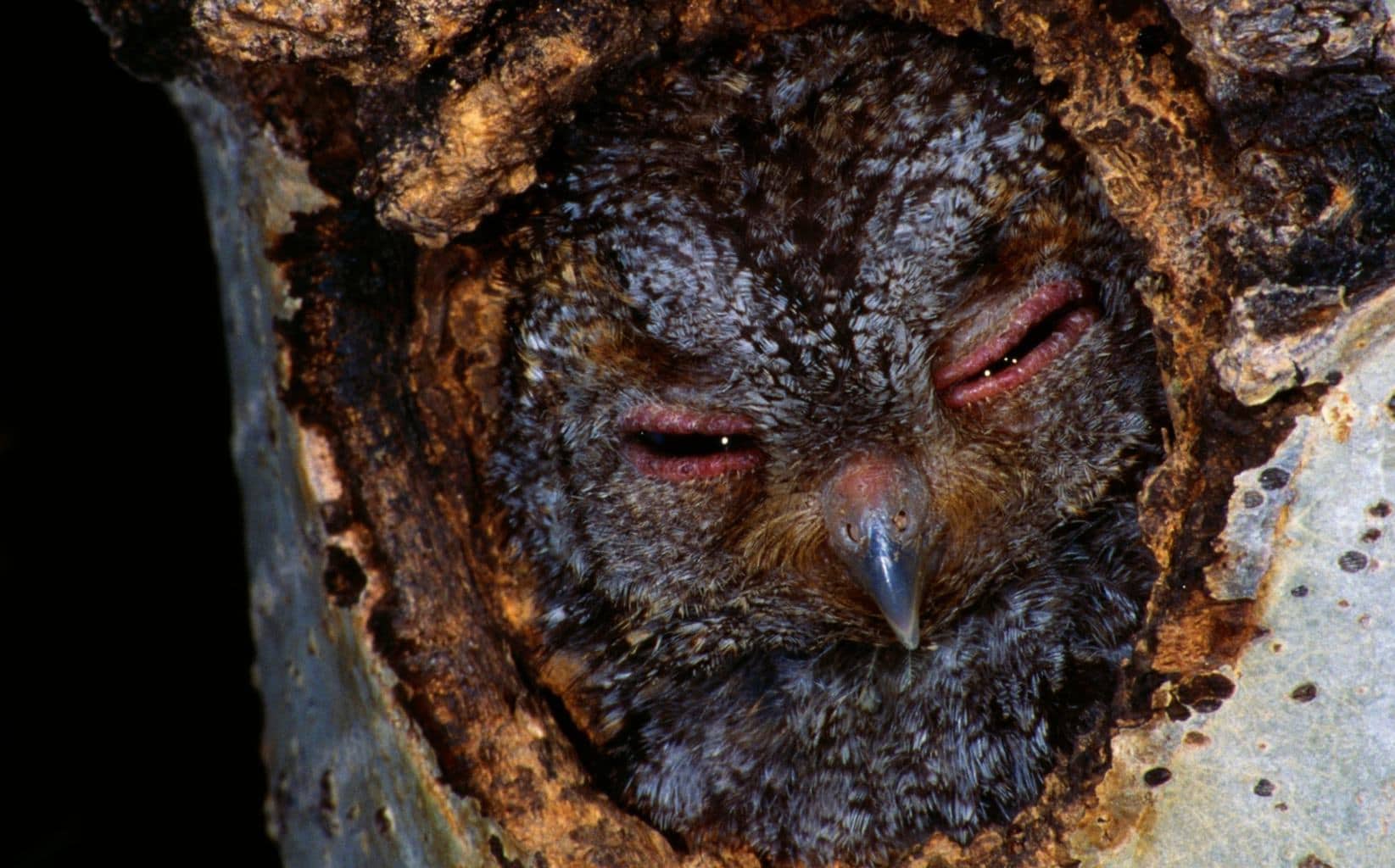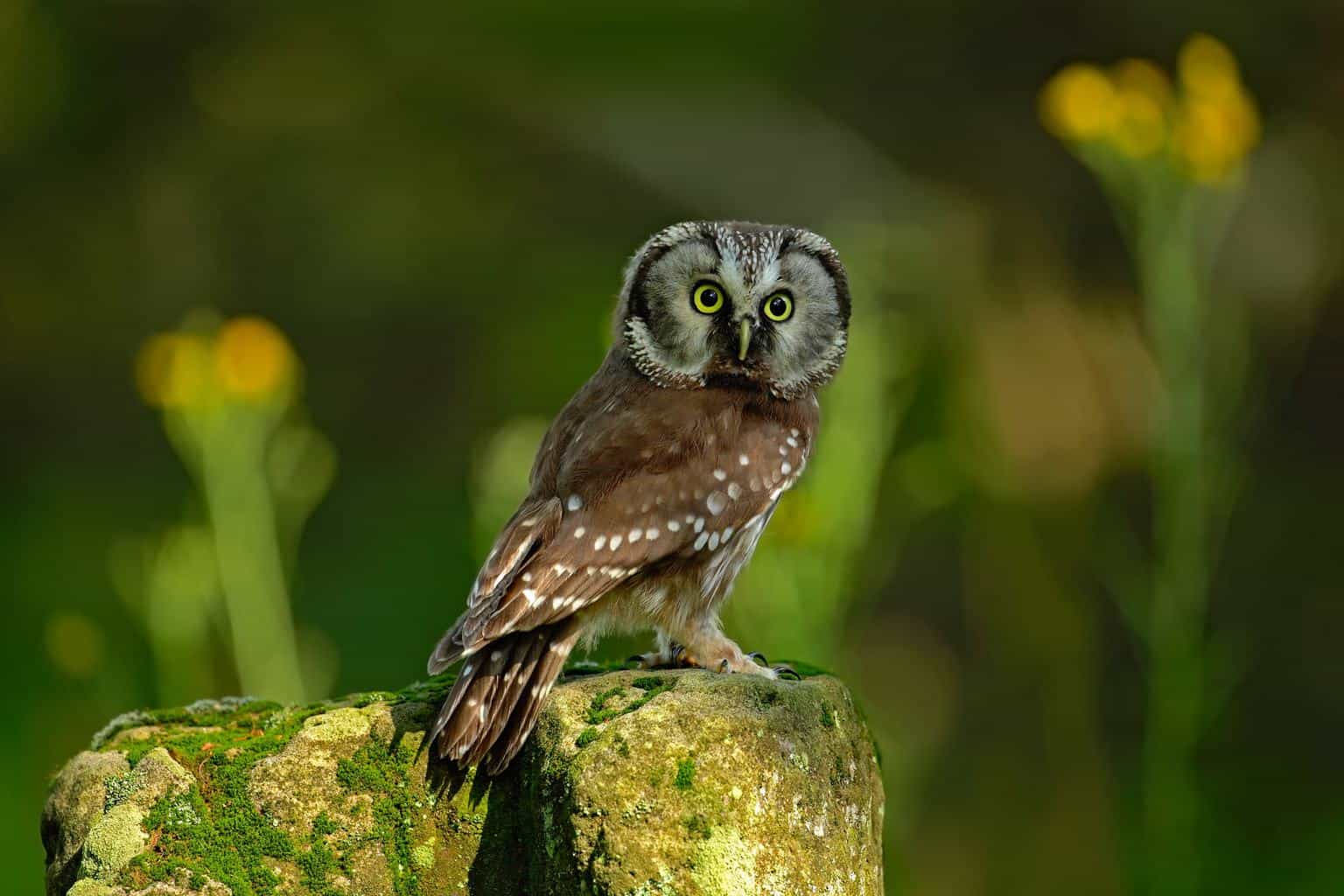Colorado, the Centennial State, has a rather unique topography that includes mountains, plains, huge dunes, deserts, canyons, and rivers that run across the land.
The central U.S. state’s welcome sign says, “Welcome to Colorful Colorado,” and those colors are clearly expressed through its diverse wildlife and natural areas. There are around 511 different bird species in various parts of the state’s wilderness, but today, our focus is on the owls.
Owls are reclusive birds that put a lot of effort toward hiding and camouflage. This is essential to both their survival and success in hunting. This would make locating the 14 species of owls that call Colorado home a bit difficult, but we’re going to show you how to identify these amazing birds.
Barn Owl

- Scientific Name: Tyto alba
- Length: 12.6-15.8 inches
- Weight: 14.1-24.7 ounces
- Wingspan: 39.4-49.2 inches
The North American barn owl is among the largest species of owls you can find. It’s mostly pale with heart-shaped facial discs. Females are more colorful and showy than their male counterparts, and this is believed to signify virility and dominance.
These night hunters follow their prey items with remarkable precision. Barn owls are highly adaptable, clever, and hide well; that’s probably why they lead long lives — up to 15 years.
When it’s time to eat, these large individuals swallow little mammals whole before spitting out their carcasses and furs or feathers as pellets. And, as you probably guessed from their name, these owls make their nests in barns or other manmade structures.
Flammulated Owl

- Scientific Name: Psiloscops flammeolus
- Length: 5.9-6.7 inches
- Weight: 1.5-2.2 ounces
- Wingspan: 15.9-16.1 inches
Next up on our list of Colorado owls is the flammulated owl, a species slightly larger than a sparrow. You’ll find it in both red and grey morphs, but unfortunately, they’re both rather difficult to see.
Flammulated owls prefer to live atop trees in woodlands, rarely coming close to the ground. They usually feed on flying insects, like moths and crickets, while occasionally chowing down on small birds and mice.
These types of owls are migratory and flee the northern regions in the winter time, probably because of the scarcity of food.
Western Screech-Owl

- Scientific Name: Megascops kennicottii
- Length: 7.5-9.8 inches
- Weight: 3.5-10.8 ounces
- Wingspan: 21.6-24.4 inches
Our feathered friend the western screech-owl prefers life on treetops, but it’s not picky; it wouldn’t mind living in any habitable spot in Colorado. This owl is tiny and strictly nocturnal, so finding it might be a little challenging. However, listen for its distinctive hoot and use its call to find it.
Even though this species of screech-owls are highly adaptable when it comes to habitat, food, and breeding habits, their numbers dwindled consistently from 1966 to the 2000s.
Eastern Screech-Owl

- Scientific Name: Megascops asio
- Length: 6.3-9.8 inches
- Weight: 4.3-8.6 ounces
- Wingspan: 18.9-24.0 inches
The eastern screech-owl is approximately the size of a robin with a plump, stocky frame, a large head, and pointed ear tufts. These owls often have grey or reddish-brown plumage marked by patterns that are amazingly similar to tree bark; this is how they camouflage themselves.
Eastern screech-owls mostly hide away in the woods and detest open clearings or mountainous areas. However, they can be coaxed into nest boxes.
These birds of prey feed on a large variety of both vertebrates and invertebrates, which proves they aren’t picky at dinnertime.
Great Horned Owl

- Scientific Name: Bubo virginianus
- Length: 18.1-24.8 inches
- Weight: 32.1-88.2 ounces
- Wingspan: 39.8-57.1 inches
Because the great horned owl is almost as large as a duck, you’ll probably be able to spot a few in Colorado. This bird can take residence almost anywhere, including manmade structures, and in addition to its massive size, large ear tufts are the bird’s most prominent identifying features.
The great horned owl is most active from dusk until dawn. They hunt on the ground as well as mid-flight, which increases the diversity of the prey they could catch.
Because these owls are large and strong, their diet includes bigger mammals like prairie dogs, house cats, ducks, and even skunks. However, they also feed on rodents, squirrels, large birds, fish, other owls, and a few invertebrates.
Snowy Owl

- Scientific Name: Bubo scandiacuso
- Length: 20.5-27.9 inches
- Weight: 56.4-104.1 ounces
- Wingspan: 49.6-57.1 inches
Snowy owls have a pretty unique appearance, thanks to their white plumage and yellow eyes. Females have more dark spots on their bodies than males do, and interestingly enough, males become paler as they age.
These owls prefer open spaces and steer clear of the woods. They look for a suitable vantage point on which to perch, then wait for the prey to approach. When they find something to eat — usually small mammals, like lemmings — they attack.
Northern Pygmy-Owl

- Scientific Name: Glaucidium gnoma
- Length: 6.3-7.1 inches
- Weight: 2.1-2.5 ounces
- Wingspan: 14.5-16 inches
Northern pygmy-owls are small birds who sport plump bodies and rather large, round heads. You’ll also notice they have visibly long tail feathers and short, round wings — you might think birds of this species are a bit out of proportion overall!
After making note of the pygmy-owl’s appearance, observe its patterns and behavior. This includes hunting during the day, which makes the bird slightly easier to find. There’s a high possibility of finding these owls around bird feeders, as this is one of their favorite hunting grounds.
Burrowing Owl

- Scientific Name: Athene cunicularia
- Length: 7.5-9.8 inches
- Weight: 5.3 ounces
- Wingspan: 21.6 inches
The burrowing owl, measuring slightly smaller than a crow, is a well-built bird with long legs and a trim tail. Its often has mottled brown feathers with a small flat head and no ear tufts. Large yellow eyes take up most of its face and match the bird’s bill.
Burrowing owls often dig little holes in the ground to live in, or they just move into abandoned burrows left behind by other animals — no surprise, considering this species’ name. When it’s time to eat, they feed mainly on insects, as they’re the easiest things for the owls to catch.
Spotted Owl

- Scientific Name: Strix occidentalis
- Length: 18.5-18.9 inches
- Weight: 17.6-24.7 ounces
- Wingspan: 39.8 inches
The spotted owl is a large and stocky bird with a prominent facial disk. Their dark eyes are outlined with white markings and recognizable patterns mark the birds’ backs, chests, and tails.
Spotted owls live in both hardwood forest habitats and deep, narrow canyons. They eat flying squirrels, woodrats, and whatever other small mammals they can find, and when they get a surplus of food, they hide it in a cool spot; they’re quite clever at memorizing the extra food’s exact location.
Since this species’ population has been consistently dwindling, this owl has been under federal protection since 1990. Habitat loss plus a fierce rivalry with barred owls has taken a toll on the spotted owl.
Barred Owl

- Scientific Name: Strix varia
- Length: 16.9-19.7 inches
- Weight: 16.6-37.0 ounces
- Wingspan: 39.0-43.3 inches
Speaking of the barred owl…it’s a large plump bird measuring just a bit smaller than a goose. The bird has strong features set in a well-defined facial disk with its dark eyes being the most prominent, and it has dark brown patterns all over its body in both horizontal and vertical configurations.
Barred owls’ preferred habitat is a thick forest next to a body of water. This seems to provide a rich supply of food plus favorable nesting conditions.
When they hunt, they do so right after sunset and extend their forays throughout the night. Occasionally, they’ll forage by day, too, which makes this species relatively easy for an avid birdwatcher in Colorado to find.
Long-Eared Owl

- Scientific Name: Asio otus
- Length: 13.8-15.8 inches
- Weight: 7.8-15.3 ounces
- Wingspan: 35.4-39.4 inches
Orange-tinted facial disks, long tufts of feathers that look like ears, and bright yellow eyes make long-eared owls easy to identify.
These birds of prey often spend their time within grasslands and shrubs where foraging is easy; they eat small mammals of various types, as long as they’re within easy reach. Then, they venture into coniferous or deciduous woods to nest and hide.
Long-eared owls are quite secretive and have mastered the arts of camouflage, so as you can imagine, they’re not that easy to find. But the best way to come across one is to listen for and follow their distinctive long hoots.
Short-Eared Owl

- Scientific Name: Asio flammeus
- Length: 13.4-16.9 inches
- Weight: 7.3-16.8 ounces
- Wingspan: 33.5-40.5 inches
You’ll know the short-eared owl by the heavily streaked plump body, yellow beady eyes, and darkly-outlined eyes that characterize them. You’ll also recognize their short tails and rather broad wings feathers
Short-eared owls live in open areas, like meadows, coastal grasslands, tundra, marshes, and agricultural areas. There, they feed primarily on little rodents, but they don’t mind grabbing a bite of a bat, lemming, or rabbit.
Boreal Owl

- Scientific Name: Aegolius funereus
- Length: 8.3-11.0 inches
- Weight: 3.3-7.6 ounces
- Wingspan: 21.6-24.4 inches
The boreal owl‘s body seems to be much smaller than its head, and its features are clustered right in the center of its facial disk. The growth of feathers on top of its flat head resembles a crew-cut, and that’s probably the bird’s most unique feature.
These owls are a common species found in the boreal forests in North America that extend to Eurasia. High elevations are more favorable to them, as that’s where they’ll find protection and suitable food.
Since they’re far from the ground and usually refrain from making any sort of noise, finding these owls isn’t too easy. But since they’re nocturnal, your best chances of doing so are at night and during March and April, when they abandon their silence and hoot until they find a mate.
Northern Saw-Whet Owl

- Scientific Name: Aegolius acadicus
- Length: 7.1-8.3 inches
- Weight: 2.3-5.3 ounces
- Wingspan: 16.5-18.9 inches
Northern saw-whet owls are compact-sized birds who sport large, round heads. Additionally, they’re characterized by a white V-shaped pattern on their foreheads along with mottled brown bodies.
These nocturnal hunters have a call that’s shrill and distinct, so you’re sure to recognize it. You can find these owls in various woodlands and forests, and when it’s time for a meal, they search for rodents, especially mice.
Conclusion
We hope you enjoy exploring Colorado’s wildlife, and even if you don’t see all 14 bird species mentioned above, the search itself is still exciting and fun. You may also come across some woodpecker holes; check out this list to be prepared for how, when, and where you might stumble upon the powerful creatures that drilled them!

